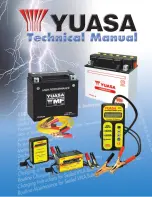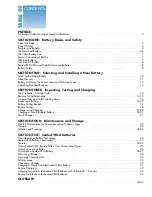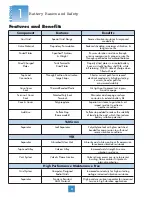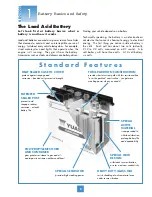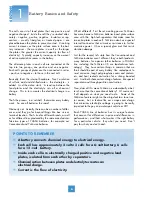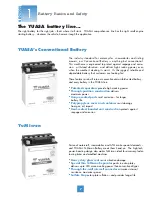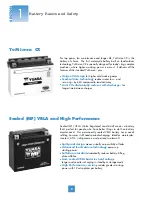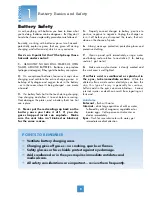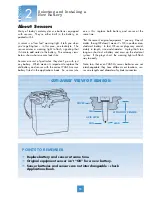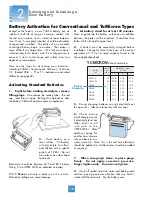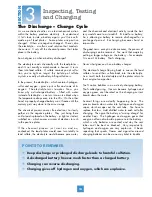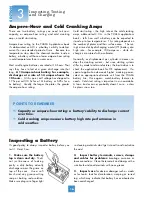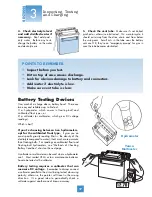
Lead acid batteries are relatively simple in design.
Dissimilar metal plates are immersed in an electrolyte
solution consisting of sulfuric acid and water. These
are then insulated from each other with a permeable,
non-conductive material, which allows the transfer of
ions. The transfer of ions occurs during the discharge
and recharge of the battery. Also occurring is the change
in specific gravity or density of the electrolyte. During
the discharge period, sulfuric acid is drawn from the
electrolyte into the pores of the plates. This reduces
the specific gravity of the electrolyte and increases the
concentration of water. During the recharge, this action
is reversed and the sulfuric acid is driven from the plates,
back into the electrolyte, increasing the specific gravity.
During the discharge, lead sulfate is being formed on the
battery plates. Although this is the normal activity within
the battery during discharge, a timely recharge is
required to drive out the sulfuric acid into the electrolyte.
Without this recharge, the lead sulfate will continue to
develop and become difficult if not impossible to
breakdown during recharge. Once this advanced
sulfation develops, permanent capacity loss or total
failure of the battery is likely. Besides the sulfation
concerns, many other detrimental actions are taking
place inside the battery while in a discharged condition.
The corrosive effect on the lead plates and connections
within the battery is greatly increased due to the reduced
specific gravity of the electrolyte. The corrosion of the
plates will typically result in a gradual reduction in
performance followed by battery failure. The corrosion
associated with the inter cell connectors and the connecting
welds will in many instances result in a sudden battery
failure. The corroded connector may have sufficient
integrity to support low drain accessories such as lights
and instruments, but lack the necessary strength to
provide the high discharge current required to start
the vehicle. This corrosive effect can also dissolve the
lead into solution, which in turn may compromise the plate
insulators and result in micro shorts. Another condition
that frequently occurs in a discharged battery is freezing.
In a deeply discharged battery, the electrolyte has a
reduced specific gravity and becomes a higher percentage
of water than sulfuric acid. During this condition, the
battery may freeze at temperatures as high as 32°F.
The electrolyte in a fully charged battery will not freeze
in temperatures down to -65°F.
Deep discharge can be created by a multitude of
conditions, but the predominant reason is neglect.
During long periods of storage, the battery state of
charge must be checked and maintained per the battery
manufacturers recommendations. Other conditions that can
drain the battery are inoperative or inadequate charging
systems on vehicles, parasitic or key off drains, loose or
dirty terminal connections, etc. Although many of these
conditions can be corrected, often the problems you
cannot correct may be overcome by a periodic charging
schedule. You can establish a routine by which you check
and charge your battery or choose to permanently attach
a Yuasa Automatic Charger while the vehicle is not in use.
When charging your battery, always refer to the
instructions on both the battery and the charger. While
maintaining your battery at a full state of charge will
insure optimum life, overcharging may significantly
reduce it. With a conventional type battery that offers
access to the cell compartments, the periodic addition of
distilled water may be required. Water loss is normal in
these batteries through the process of electrolysis and
evaporation. Low electrolyte levels that expose the lead
plates to the air will result in permanent damage to the
battery. Maintain the electrolyte levels above the
minimum fill lines on the battery and at or below the
maximum line. A sealed VRLA (Valve Regulated Lead
Acid) battery should be maintained with the same care
as a conventional type battery with the exception of the
addition of distilled water. Sealed VRLA batteries
have a predetermined quantity of electrolyte added at
the factory or in the field using the acid bottle specified
for the battery. Once activated, the battery is permanently
sealed and must never be opened.
A little bit of care and understanding of how your battery
operates and is maintained will insure maximum service life.
A Practical Understanding
of Lead Acid Batteries
PREFACE
2
Summary of Contents for SmartShot Automatic 12V 1.5 Amp 5 Stage
Page 1: ......

